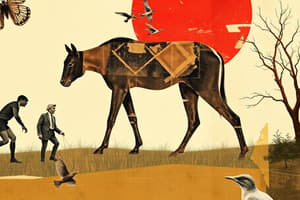Podcast
Questions and Answers
What is the primary mechanism of natural selection?
What is the primary mechanism of natural selection?
- Reproductive isolation
- Survival of the fittest traits (correct)
- Random genetic drift
- Gene flow between populations
Which of the following best describes genetic variation?
Which of the following best describes genetic variation?
- Mechanisms by which genes are passed down
- Differences among individuals in a population (correct)
- The process leading to extinction of species
- The transfer of genes between two species
What significant change occurred in the evolutionary lineage of horses from Hyracotherium to modern Equus?
What significant change occurred in the evolutionary lineage of horses from Hyracotherium to modern Equus?
- Ability to live in forest environments
- Increase in the number of toes
- Decrease in body size
- Development of a single solid hoof (correct)
How did the dental adaptations of horses evolve with their environment?
How did the dental adaptations of horses evolve with their environment?
What distinguishes Mesohippus from its predecessors?
What distinguishes Mesohippus from its predecessors?
What evolutionary significance do horses represent in relation to environmental changes?
What evolutionary significance do horses represent in relation to environmental changes?
Which species in the evolutionary lineage of horses is characterized by distinct features of modern horses?
Which species in the evolutionary lineage of horses is characterized by distinct features of modern horses?
Which factor does NOT contribute to speciation?
Which factor does NOT contribute to speciation?
Study Notes
Evolutionary Biology
- Definition: Study of the processes that explain the diversity of life on Earth through mechanisms such as natural selection, mutation, gene flow, and genetic drift.
- Key Concepts:
- Natural Selection: Mechanism whereby organisms better adapted to their environment tend to survive and produce more offspring.
- Genetic Variation: Differences among individuals in a population that are the result of mutations, gene recombination, and other factors.
- Speciation: The process by which populations evolve to become distinct species.
- Phylogenetics: Study of evolutionary relationships among biological species based on genetic, morphological, or behavioral data.
- Adaptation: Traits that enhance survival and reproduction in a specific environment.
Evolution of Horses
-
Early Ancestors:
- Hyracotherium (Eohippus): Small, forest-dwelling ancestor (~50 million years ago) with a dog-like appearance; had multiple toes.
-
Evolutionary Changes:
- Size Increase: Over millions of years, horses became larger, adapting to open grassland environments.
- Reduction of Toes: Transition from multiple toes to a single solid hoof; improved speed and efficiency in running.
- Dental Adaptations: Development of high-crowned teeth suitable for grazing on tough grasses.
-
Key Species in Evolutionary Lineage:
- Mesohippus: Lived around 32 million years ago; transitional form with three toes on each foot.
- Merychippus: Existed around 20 million years ago; had a more horse-like appearance and was better adapted for grazing.
- Hipparion: Lived around 11 million years ago; exhibited features of modern horses but was larger and had more distinct toes.
- Equus: The modern horse genus, appeared around 4-5 million years ago; characterized by a single hoof and numerous adaptations for speed and endurance.
-
Evolutionary Significance:
- Horses demonstrate how environmental changes (e.g., shifts from forest to grassland) can drive evolutionary adaptations.
- Fossil records provide insights into the morphological and ecological changes over time.
Evolutionary Biology
- Study of processes explaining Earth's biodiversity through natural selection, mutation, gene flow, and genetic drift.
- Natural Selection: Organisms best suited to their environment survive and reproduce more effectively.
- Genetic Variation: Differences among individuals in a population arise from mutations and gene recombination.
- Speciation: Populations evolve to become distinct species through evolutionary processes.
- Phylogenetics: Examines evolutionary relationships using genetic, morphological, and behavioral data.
- Adaptation: Traits that improve survival and reproduction in specific environmental contexts.
Evolution of Horses
- Hyracotherium (Eohippus): Early horse ancestor from approximately 50 million years ago; small, dog-like, with multiple toes and forest habitat.
- Size Increase: Over time, horses grew larger to adapt to open grassland conditions.
- Reduction of Toes: Evolution transitioned from multiple toes to a single hoof, enhancing speed and running efficiency.
- Dental Adaptations: Evolution of high-crowned teeth allowed horses to graze on tough grasses effectively.
- Key Species in Evolutionary Lineage:
- Mesohippus: Lived around 32 million years ago; featured three toes on each foot, representing a transitional form.
- Merychippus: Existed about 20 million years ago; had a more horse-like appearance and better grazing adaptations.
- Hipparion: Lived around 11 million years ago; larger than modern horses, with more distinct toes.
- Equus: Modern horse genus appeared 4-5 million years ago; characterized by a single hoof and adaptations for speed and endurance.
- Evolutionary Significance: Horses illustrate how environmental changes, like shifts from forest to grassland, drive evolutionary adaptations, supported by fossil records showing morphological and ecological changes over time.
Studying That Suits You
Use AI to generate personalized quizzes and flashcards to suit your learning preferences.
Description
Explore the fascinating processes of evolutionary biology, including natural selection, genetic variation, and speciation. This quiz also delves into the evolution of horses, tracing back to their early ancestors like Hyracotherium. Test your knowledge on how species adapt and evolve over time.



